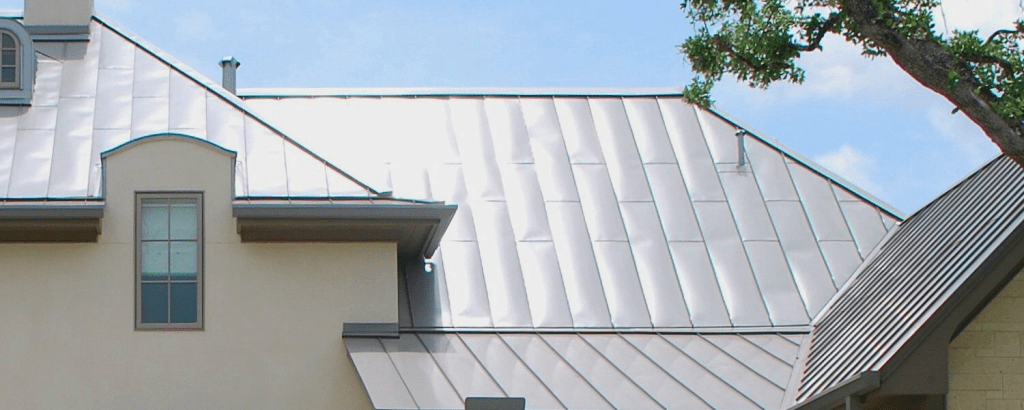When considering roofing options, many homeowners are curious about the energy efficiency and cooling benefits of different materials. One question that often arises is, “Do metal roofs help with cooling?” The answer is a resounding yes. In this article, we will delve into how metal roofs contribute to cooling, the science behind their effectiveness, and additional benefits that make them a smart choice for any home.

Understanding How Metal Roofs Help With Cooling
The Reflective Properties of Metal Roofs
One of the primary reasons metal roofs excel at cooling homes is their reflective properties. Metal roofs are designed to reflect a significant portion of the sun’s rays, reducing the amount of heat absorbed by the building. This reflective capability, measured by the Solar Reflectance Index (SRI), is particularly high in metal roofing materials.
- High SRI Values: Metal roofs typically have SRI values ranging from 25 to 95, depending on the color and finish. Lighter colors and reflective coatings can increase the SRI, enhancing the roof’s ability to reflect solar radiation.
- Reduction in Heat Absorption: By reflecting more sunlight, metal roofs absorb less heat compared to traditional roofing materials like asphalt shingles, which can have low SRI values and tend to absorb more heat.
Read too: How To Replace A Mobile Home Roof: Step-by-Step Guide for Homeowners
Thermal Emittance and Heat Dissipation
In addition to reflecting sunlight, metal roofs also have high thermal emittance. This means they are effective at releasing any absorbed heat, allowing the roof surface to cool quickly once the sun goes down.
- High Thermal Emittance: Metal roofs can have thermal emittance values as high as 0.90, meaning they emit 90% of the absorbed heat. This rapid heat dissipation helps to cool the building’s interior, particularly during the evening and night.
- Cooler Indoor Temperatures: The combination of high reflectance and high thermal emittance results in lower indoor temperatures, reducing the reliance on air conditioning systems.
Insulation and Ventilation Enhancements
Proper installation of metal roofs often includes improved insulation and ventilation systems, further enhancing their cooling capabilities.
- Insulation Layers: Adding reflective insulation layers beneath the metal roof can enhance energy efficiency by preventing heat transfer into the home.
- Ventilation Systems: Adequate ventilation allows hot air to escape from the attic, maintaining a cooler roof surface and reducing overall indoor temperatures.
Advantages of Metal Roofs Beyond Cooling
Energy Efficiency and Cost Savings
The cooling benefits of metal roofs translate directly into energy efficiency and cost savings.
- Reduced Cooling Costs: Homes with metal roofs often experience a 10-25% reduction in cooling costs during the summer months. This can lead to significant savings on energy bills over the roof’s lifespan.
- Increased HVAC Efficiency: By reducing the heat load on the building, metal roofs allow HVAC systems to operate more efficiently, prolonging their lifespan and reducing maintenance costs.
Environmental Benefits
Metal roofs are not only beneficial for homeowners but also for the environment.
- Recyclability: Metal roofing materials are typically made from recycled content and are fully recyclable at the end of their life, reducing landfill waste.
- Energy Conservation: By reducing energy consumption for cooling, metal roofs contribute to lower greenhouse gas emissions, helping to combat climate change.
Longevity and Durability
Metal roofs are known for their durability and long lifespan, providing additional value to homeowners.
- Long Lifespan: Metal roofs can last 40-70 years, far longer than traditional asphalt shingles, which may need replacement every 20-30 years.
- Weather Resistance: Metal roofs are resistant to extreme weather conditions, including high winds, heavy rain, and hail, making them a reliable choice for various climates.
Do Metal Roofs Help With Cooling? The Evidence
Case Studies and Real-World Examples
Numerous studies and real-world examples demonstrate the cooling benefits of metal roofs.
- Case Study – Florida: In a study conducted by the Florida Solar Energy Center, homes with metal roofs showed a significant reduction in cooling energy use compared to homes with asphalt shingle roofs. The study found that homes with metal roofs used up to 25% less energy for cooling.
- Case Study – California: A research project in California revealed that homes with metal roofs experienced lower attic temperatures, resulting in reduced cooling loads and increased comfort levels.
Testimonials from Homeowners
Homeowners who have installed metal roofs often report noticeable improvements in indoor comfort and reductions in energy bills.
- Homeowner Testimonial – Texas: “Since we installed our metal roof, our home stays much cooler in the summer. Our energy bills have dropped, and we no longer need to run the air conditioner as often.”
- Homeowner Testimonial – Arizona: “The difference in temperature is remarkable. Our metal roof has made a huge impact on our home’s comfort level, especially during the hottest months.”
Considerations for Installing Metal Roofs
Initial Cost vs. Long-Term Savings
While metal roofs may have a higher initial cost compared to traditional roofing materials, the long-term savings in energy bills and maintenance often justify the investment.
- Higher Upfront Cost: Metal roofs typically cost more to install due to the materials and specialized labor required.
- Long-Term Value: The reduction in energy costs, combined with the roof’s longevity and durability, provides long-term value and return on investment.
Professional Installation
To maximize the cooling benefits and ensure the roof’s performance, professional installation is crucial.
- Experienced Contractors: Hiring experienced contractors who specialize in metal roofing ensures proper installation, including insulation and ventilation enhancements.
- Warranty Considerations: Professional installation often comes with warranties that protect the homeowner and ensure the roof’s longevity.
Conclusion
In answering the question, “Do metal roofs help with cooling?” the evidence is clear. Metal roofs provide significant cooling benefits through their reflective properties, high thermal emittance, and enhanced insulation and ventilation systems. These benefits translate into energy efficiency, cost savings, and improved indoor comfort. Additionally, metal roofs offer environmental advantages, longevity, and durability, making them a wise choice for homeowners looking to invest in a sustainable and effective roofing solution.



Leave a Reply